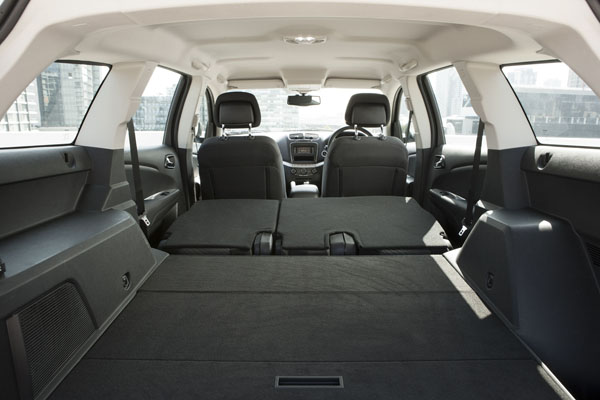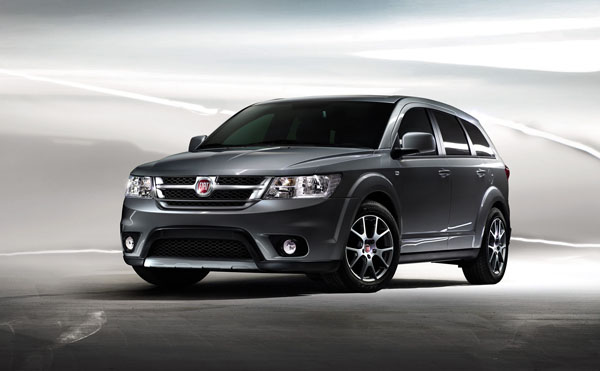The first Fiat to be produced in partnership with the Chrysler Group, the Freemont has a touch of the quirkiness of Italian cars of old, plus the practicality of a modern American family vehicle.
Available in three specification levels – Base, Urban and Lounge – Freemont is powered by a petrol or diesel engine, it comes in two-wheel drive guise only, with power put to ground up front via a six-speed automatic (petrol), or six-speed manual (diesel) transmission.
Base, Urban and Lounge models come with a 2.4-litre four-cylinder petrol engine mated with a six-speed automatic transmission, while the Urban is also available with a 2.0-litre diesel motor putting power through a six-speed manual gearbox.
The 2.4-litre petrol engine produces up to 125 kW of power, and 220 Nm or torque at 4500 rpm while the turbo-diesel engine achieves 125 kW at 4000 rpm and 350 Nm between 1750 and 2500 revs. Both engines were developed by Fiat, which is one of the world’s leading engine designers.
With a standard five-seat layout and up to 1461 litres of cargo space, Freemont comes with the option of seven places courtesy of a third row of seats.
This Fiat is the poster boy for passenger cabin storage with more than 20 compartments, making it one of the most family friendly vehicles around.
Passenger convenience is paramount. From the word go the Freemont is welcoming, the rear doors fitted with a new three-stage 90-degree hinge, which when fully open, offers space to load a child seat into the second row or to provide easy access to the third row.
Initially opening to 26 degrees, the door allows passengers to get out without smashing the door against another vehicle parked close by. A second 58-degree position is wide enough to allow passengers to enter the cabin easily.

Access to the rear cargo area, or optional third row of seats where fitted, is made all the more easy by a ‘Tip ‘N Slide’ system, with one simple movement of a conveniently placed lever on the side of the backrest.
Ambient lighting sets the scene for occupants who are offered a good all-round view no matter where they are positioned thanks to stadium-style seating which rises in height from front to back row. Rear storage space is set off by a front passenger seat cushion that can be moved forward to reveal a compartment which can be used to store personal belongings. The back of the seat folds forward to transport long objects.
The backrest of the second row of seats is foldable in a 60:40 ratio, the central section can be folded separately to form an armrest and includes two cup holders and a compartment for storing small objects.
There’s even storage under foot with the floor of the second row housing two lidded compartments with removable and washable bins offering more than 12 litres of space.
The Freemont Urban test vehicle was powered by the 2.0 MultiJet 2 diesel motor equipped with a variable geometry turbocharger and state-of-the-art second generation MultiJet technology earning a top-rate Euro 5 emission standard.
With maximum torque of 350 Nm coming in at a low 1750 rpm and constant up to 2500 rpm, performance was impressive. During normal usage up to 3000 revs, with torque not falling below 300 Nm, gear shifts were kept to a minimum and uncomfortable downshifts avoided. Acceleration was leisurely, but who cares? This isn’t a sports wagon.
Our test car with the diesel engine clocked just five litres per 100 kilometres at a steady 100km/h on the highway and straddled seven litres / 100 km in day-to-day city work.
The test vehicle scored well with acceptable engine noise in the cabin during normal operation. However, the hill holder function was reluctant to let go, giving the driver cause to over-rev the engine at times. When the brake was finally let loose, the Freemont surged, the wheels at one time spinning with an embarrassing squeal. My solution was to blip the throttle to release the brake, then move off.
Reverse gear tended to be a bit hit and miss, needing firm handling of the gear lever, while headlamps suffered from a narrow lateral arc of operation, with predominant illumination limited to straight ahead, leaving the driver in the dark on turning corners at night.
There is no argument about the Freemont’s safety features with more than a third of the vehicle’s structure including high strength steel sheets designed to optimise the body’s weight and structural resistance.
The extensive use of dual-phase steel in the front and rear side members and tunnel reinforcement mean these components can handle larger loads with relatively limited dimensions, thus saving weight without sacrificing structural strength.
Active safety systems include anti-skid braking with electronic brake force distribution, electronic stability program and traction control, electronic roll-over mitigation, plus the aforementioned hill holder.
Tyre pressures are constantly monitored and the driver warned of any problems, and rear parking sensors alert the driver to objects in the way.
Passive safety is in the hands of six airbags, fitted as standard on all vehicles in the range, along with active headrests and three-point seatbelts for all seats. The front seatbelts are also equipped with pretensioners and load limiters.
Isofix attachments and child boosters ensure children are seated correctly.
Starting at a less than $26,000, the family friendly Freemont is a Latin enigma: a little bit wagon; a little bit people mover.
AT A GLANCE
PRICING AND SPECIFICATIONS
Fiat Freemont Base 2.4-litre petrol: $25,990 (automatic)
($27,000 drive away) Fiat Freemont Urban 2.4-litre petrol: $28,300 (automatic) Fiat Freemont Lounge 2.4-litre petrol: $30,300 (automatic) Fiat Freemont Urban 2.0-litre diesel: $32,600 (manual)
Note: With the exception of the optional drive-away price for the Freemont Base, the above prices do not include government or dealer delivery charges. Contact your local Fiat dealer for drive-away prices on these models.
SPECIFICATIONS (Fiat Freemont Urban 2.0-litre diesel)
ENGINE
Capacity: 1956 cc
Configuration: 4 cylinders in line. Common rail direct injection
Bore and stroke: 83 mm x 90.4 mm
Compression ratio: 16.5:1
Fuel type: Diesel
Maximum Power: 125 kW @ 4000 rpm
Maximum Torque: 350 Nm from 1750-2500 rpm
DRIVELINE:
Six-speed manual, front-wheel drive
DIMENSIONS, WEIGHT AND CAPACITIES:
Length: 4910 mm
Width: 1878 mm
Height: 1705 mm / 1751 (with roof bars)
Wheelbase: 2890 mm
Track: 1571 mm (front); 1582 mm (rear)
Overhang: 989 mm (front); 1009 mm (rear)
Turning circle: 10 m
Seats / boot capacity: 5 / 784 litres (rear seat back up), 1461 litres (rear seat back folded)
Tare mass: 1874 kg
Towing, max weight: 1250 kg (braked); 450 kg (unbraked)
SUSPENSION AND BRAKES:
Front Suspension: Independent, MacPherson type with anti-roll bar
Rear Suspension: Independent, Multilink type with wishbones, anti-roll bar, coil
springs and telescopic shock absorbers
Brakes: Front, ventilated discs (302 mm); rear, discs (305 mm). Anti-lock Braking System (ABS) with Electronic Brake Force Distribution (EBD), Electronic Stability Control (ESC), Hill Holder, Rollover Mitigation
Steering: Hydraulic rack and pinion
Wheels / tyres: 17 in alloy / 225/65R17
PERFORMANCE:
Acceleration 0-100 km/h: 11sec
Maximum speed: 195 km/h
FUEL CONSUMPTION:
Combined Cycle (ADR 81/01): 6.3 L/100km, CO2 emissions 169 g/km
Emission standard: EU5
GREEN VEHICLE GUIDE RATINGS:
Greenhouse Rating: 7 / 10 Air Pollution Rating: 5 / 10










